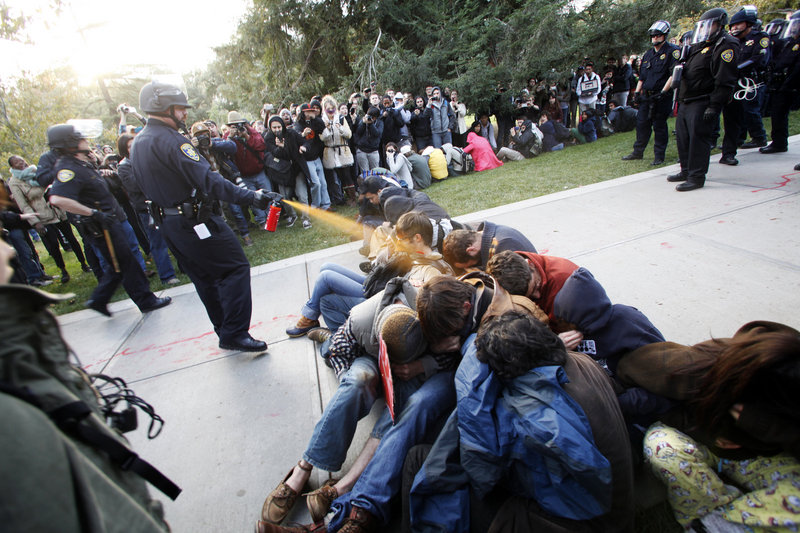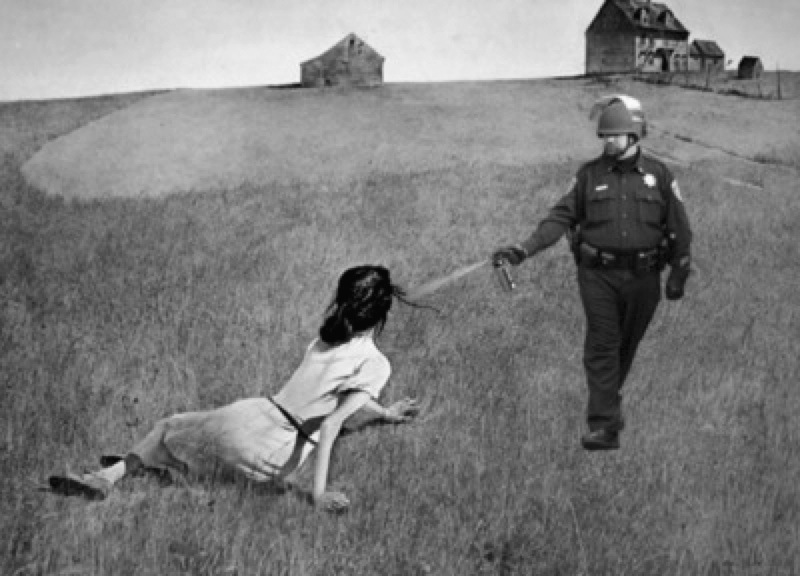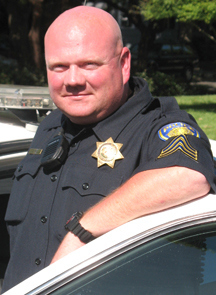PHILADELPHIA – Campus police Lt. John Pike probably never thought he’d ever be famous. Certainly not like this.
Pike is now more than a person, more than a news event. He has become a meme.
He has joined the ranks of Achmed the Dead Terrorist, Dramatic Squirrel and Double Rainbow Guy.
Pike is the police officer who, with “OK, be that way” nonchalance, pepper-sprayed students sitting in a protest at the University of California, Davis, last Friday. In videos, Pike shows the spray can to the crowd and then serves its contents upon the squatters as if distributing a malign sacrament.
In this autumn of Occupy, the Davis protest wasn’t huge — nonviolent, if you discount sore throats and eyes. A decade ago, it might have been only a blip on the news horizon.
But what happened next made it, and Pike, into a meme. The evolutionary scientist Richard Dawkins coined that term to mean an idea or practice that spreads from mind to mind throughout a culture. Anything that the Web can spread — an image, a slang term, a dance move — can be a meme.
The meme-ing of Pike shows how the Web and social media can transform once-middling events into vibrant, possibly immortal, cultural artifacts.
“Relatively insignificant events can be bolstered by becoming a meme,” says Joshua Wolford, a staff writer for the site WebProNews. “Once the meme culture takes hold of it, it spreads like wildfire on sites like Facebook and (social media news site) reddit. … I think memes have the power to make any little thing that happens have more impact and stick around a bit longer — at least on the Internet.”
Michael X. Delli Carpini, dean of the Annenberg School for Communication at the University of Pennsylvania, says the meme-ing of Pike “captures a lot of what’s exciting — and what’s hard to wrap your head around — about our Web and media environment.”
The pepper-spraying happened on a Friday afternoon, playing into the ever-hungry maw of the 24/7 weekend cable news cycle. Cable outlets grabbed the video and, replaying and replaying it, flogged it within an inch of its pixels. Then it viralized, shooting around the Web faster than the speed of thought, drawing thousands of viewers on YouTube.
Clever Web jockeys took still images of Pike in mid-spray and — using image-manipulation programs such as Photoshop — imported him into great works of art, famous news photos, movie scenes and other images, in a sidesplitting, sometimes brilliant, phantasmagoria of recontextualization. One leader was James Alex, who posted Pike mash-ups on his Tumblr blog, peppersprayingcop.tumblr.com. People picked up the idea and ran mad with it.
On thousands of websites, Pike now pepper-sprays:
• A defenseless baby seal pup in the frozen Arctic wastes.
• Denver Broncos quarterback Tim Tebow kneeling in prayer after a game.
• A barefoot Paul McCartney on the album cover of the Beatles’ “Abbey Road.”
• Anna Christina Olson in Andrew Wyeth’s “Christina’s World.”
• The Declaration of Independence in John Trumbull’s famous painting of the signing.
• Jesus in Leonardo da Vinci’s “Last Supper.”
• God the Father in Michelangelo’s Sistine Chapel frescoes.
These images, in turn, were viralized all over again. (For a selection of Pike at his peak, go to http://huff.to/sT0uvI.)
Yes, collegiate high jinks. But they have also had immediate impact. Pike has been placed on leave, along with another officer and UC Davis Police Chief Annette Spicuzza.
Facing calls to step down, UC Davis Chancellor Linda Katehi has apologized for the spraying. So has University of California president Mark C. Yudof, calling chancellors of all 10 university campuses into a huddle. Thousands of alumni got his apology by email, along with a video by UC Board of Regents chair Sherry Lansing, who said she and Yudof were “simply shocked and appalled by these images.” Both promised “systemwide procedures to ensure that students can engage in peaceful protests.”
Delli Carpini says the potent silliness of the meme-ing “blurs the lines between news and entertainment. There’s news there, important news, but by making it into an artifact that’s entertaining, it somehow changes the nature of it.”
Comedy has been part of the Occupy movement from the beginning. Its refusal to take either itself or its opponents seriously is Weblike, tending to strengthen, not weaken, the message.
So what does it all meme, that is, mean? It means the news becomes more than news — it becomes culture. In the great turning world of significance, the Davis incident isn’t all that, but the cop-with-pepper-spray meme keeps it going, becoming a 24/7 form of satire and protest.
Andrew Mendelson, chair of the department of journalism at Temple University, points to Pike’s nonchalance: “The body language he shows in spraying, transposed into these pictures, works really well as a visual representation of the shared frustrations among the Occupy community at the way they’re being treated by mainstream media and the police.”
“That image was just too striking not to stick with people,” Wolford says.
Delli Carpini: “Think of the uses of this meme. It’s being used to spark discussion about what the event means, about civil rights, about Occupy, about what’s going on right now on campuses across the country.”
It also shows that the walls have fallen between producers of news and consumers of news. Millions today have the tools for making videos and manipulating images – tools once reserved for a professional elite. “And,” Delli Carpini says, “we have the media environment to distribute images and materials that once you would have seen only on the nightly news.”
Send questions/comments to the editors.





Success. Please wait for the page to reload. If the page does not reload within 5 seconds, please refresh the page.
Enter your email and password to access comments.
Hi, to comment on stories you must . This profile is in addition to your subscription and website login.
Already have a commenting profile? .
Invalid username/password.
Please check your email to confirm and complete your registration.
Only subscribers are eligible to post comments. Please subscribe or login first for digital access. Here’s why.
Use the form below to reset your password. When you've submitted your account email, we will send an email with a reset code.